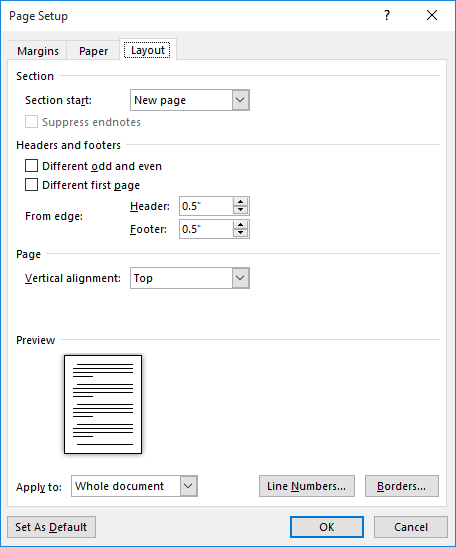Please Note: This article is written for users of the following Microsoft Word versions: 2007, 2010, 2013, 2016, 2019, and 2021. If you are using an earlier version (Word 2003 or earlier), this tip may not work for you. For a version of this tip written specifically for earlier versions of Word, click here: Odd & Even Headers and Footers.
Written by Allen Wyatt (last updated May 9, 2020)
This tip applies to Word 2007, 2010, 2013, 2016, 2019, and 2021
As you have learned in other WordTips, Word allows you to easily add headers and footers to your document. You can also specify that different headers and footers be used for both odd and even pages. Word will then automatically determine which footer is the proper one to use for the given page. To define separate odd and even headers or footers, do the following:

Figure 1. The Layout tab of the Page Setup dialog box.
Now you can set the headers and footers:
WordTips is your source for cost-effective Microsoft Word training. (Microsoft Word is the most popular word processing software in the world.) This tip (9803) applies to Microsoft Word 2007, 2010, 2013, 2016, 2019, and 2021. You can find a version of this tip for the older menu interface of Word here: Odd & Even Headers and Footers.

Learning Made Easy! Quickly teach yourself how to format, publish, and share your content using Word 2021 or Microsoft 365. With Step by Step, you set the pace, building and practicing the skills you need, just when you need them! Check out Microsoft Word Step by Step today!
Want to include the file name of a document on the printed copy without rearranging the layout? You can use a header or ...
Discover MoreHeaders and footers can add a final, professional touch to your printed document. Here's the quick way to add the headers ...
Discover MoreHeaders and footers provide a nice final touch for your printed documents. If you want to expertly align text in those ...
Discover MoreFREE SERVICE: Get tips like this every week in WordTips, a free productivity newsletter. Enter your address and click "Subscribe."
There are currently no comments for this tip. (Be the first to leave your comment—just use the simple form above!)
Got a version of Word that uses the ribbon interface (Word 2007 or later)? This site is for you! If you use an earlier version of Word, visit our WordTips site focusing on the menu interface.
Visit the WordTips channel on YouTube
FREE SERVICE: Get tips like this every week in WordTips, a free productivity newsletter. Enter your address and click "Subscribe."
Copyright © 2026 Sharon Parq Associates, Inc.
Comments